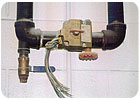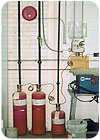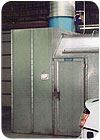
When designing a fire sprinkler system for a new or existing building, all kinds of fun little words seem to jump right off the page into the eyes of a fire protection engineer. Words like: rubber tires…plastics…petroleum…inks…nitrocellulose film…process vessel…oxygen tank…roll paper…propane…acetylene…foam rubber…and my favorite-polyethylene.
This is just a short list consisting solely of hazardous commodities. Other words that jump out at fire protection engineers concern places where certain commodities may be found: throughout rack storage, behind theatrical stages, or within paint spray booths. The term “spray booth” is just what the name implies. It refers to a self-contained boxlike “booth” that physically surrounds paint spray operations.
The most popular version is the “open front” arrangement, which has a ventilation system used to control airflow and remove flammable vapors to a safe location. Spray booths are large and awkward-looking metal contraptions/power-ventilated structures that have an innocent appearance about them that hides a very real fire threat.

What
is glaringly omitted from this separate spray booth system setup is signage for
the control valve and the 1-inch ball valve serving as an auxiliary drain, and
more importantly-the connecting alarm wiring for the built-in tamper switch.
Proper Protection, Simple Design
Automatic sprinkler protection must protect the booth interior, the area(s) behind the filters, and the interior of the exhaust duct. It is imperative that the exhaust duct be properly protected because this ductwork is difficult to keep clean and a haven for accrued overspray deposits, which may lead to an occurrence of spontaneous ignition.
The fire protection system design is fairly simple and originates with a feed main taken from the overhead sprinkler system. This line drops to an area on the side of the spray booth or an adjacent wall, complete with an accessible and supervised control valve and a 1" auxiliary drain. Appropriate signage (red lettering on a white background) should clearly identify both the control and drain valves. It is not a bad idea to include a durable metal sign on the booth itself reading, “Danger-Flammable Liquids.”
NFPA 33,Spray Application Using Flammable or Combustible Materials, requires that the sprinkler system protecting the spray booth be designed for Extra Hazard Group II. Sprinkler spacing inside the booth must not exceed 90 sq. ft., and the sprinklers should be installed inside ducts every 12 feet or less. A separate alarm is not necessary.
Paint spray booths are a common presence within most automobile dealerships and body shops. If that building is sprinklered, its system will be designed for an Ordinary Hazard Class II occupancy for the service areas, parts department, body shop, car wash and similar areas. Rarely will a fire spread from the spray booth to other areas because the fuel contained within the booth is consumed very quickly, and the ventilation system continues to pull heat and flammable vapors away through the ductwork to the outside of the building.

This
dry chemical setup adjacent to a large spray booth operates effectively without
a source of water for fire protection.
In colder climates, the sprinkler protecting the exhaust plenum and ductwork is typically a dry pendent or dry sidewall sprinkler, a routine practice explicitly endorsed by the writers of NFPA 33. Accumulated loading or coating of fire sprinklers within the booth is to be avoided, so some methodology must be adopted in order to prevent paint spray from reaching the sprinklers. A thin plastic or paper bag tied around the sprinkler base is the usual cost-effective application. Polyethylene or cellophane bags, with a maximum thickness of 0.003 inches, work best.
If the sprinklers do become coated they must be cleaned or replaced. If the sprinkler is reasonably accessible, motor oil or Vaseline can be used to break down and wash off deposits. The temperature rating for these sprinklers inside the booth should be as low as possible-a rating of 135

The
electrical lighting for this spray booth is situated behind a rated glass
panel, which is sealed to prevent leakage of vapors or mist at the edges.
CO2 systems are another option, but not one that is often undertaken for spray booths. CO2 attacks the fire by lowering the oxygen content. When O2 falls below 15%, the fire goes out. However, this total flooding process takes awhile to extinguish the fire. Combine that with the inherent life safety issue, and it’s easy to see why a dry chemical agent or standard fire sprinklers are the preferred mode for spray booth suppression. The use of halon in spray booths-much more expensive, but a method that does extinguish fire quickly-has been outlawed for quite some time due to the ozone-depleting nature of halogenized agents.
Not to be overlooked are the following advisories:
- Spray booths should be constructed of 18-gauge steel;
- Flooring should be non-combustible and easy to clean;
- The exhaust duct should be sufficiently supported and run as directly as possible to the outside atmosphere;
- Spark-producing and/or open flame equipment used for welding or cutting shall be located in separate plant locations;
- No electrical equipment or switches should be located within the booth.
There are no code parameters or cutoff points for the amount of flammable or combustible liquids used in spray booths, or for the frequency of their use. But all spraying operations that utilize flammable or combustible materials must be protected by some type of automatic fire suppression. If the system employed uses automatic fire sprinklers, the system must be hydraulically calculated per NFPA 13 criteria, but need not include surrounding overhead sprinklers.